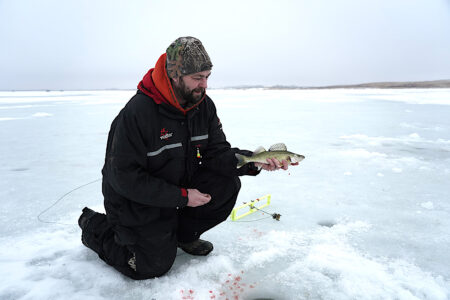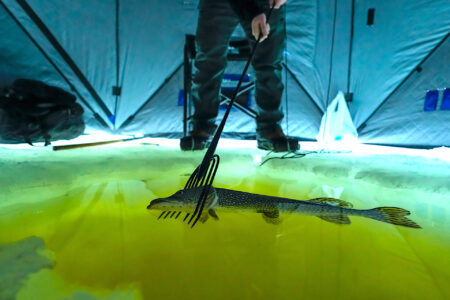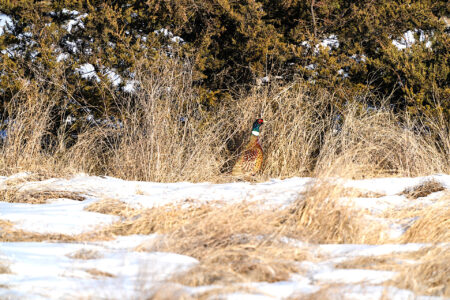Fishing southern Saskatchewan
OXBOW, SASK. – The main boat ramp is top quality with docks on both sides. The fishing is excellent, too. Welcome to Alameda Dam, one of the featured summer playgrounds of southern Saskatchewan.
There are no cabins or summer homes along Alameda Reservoir, but the Moose Mountain Creek complex does have a large campground, small store, nine-hole golf course with a clubhouse and restaurant, a storage area for all types of watercraft, an enclosed fish cleaning station and plenty of friendly people. Some come for golf, some for camping, some for fun on the water and some just love to fish. In addition to the main boat ramp, a few primitive launch sites are located along the lake.
Construction of Alameda Dam was completed in 1995. It was part of a flood control initiative proposed by Minot’s city leaders who were seeking solutions to prevent flooding such as what occurred in the city in 1969. The 1969 flood was the most costly flood in Minot’s history, until it was far surpassed by the flood of 2011.
The primary water source for Alameda is Moose Mountain Creek, a lengthy drainage that begins in the area of Montmarte, Sask., and flows approximately 120 miles before entering Alameda. Moose Mountain Creek joins the Souris River just south of Oxbow. Oxbow is located in southeast Saskatchewan, about 105 miles from Minot.
Normal summer operating level at Alameda, as set by an International Operating Agreement, is 562 meters or 1,843.92 feet. According to the agreement, flood storage set aside for the protection of Minot and other interests along the Souris is from 562 meters to 567 meters, or 16.40 feet of storage.
The water-holding capacity of Alameda is nearly identical to Lake Darling, which is located northwest of Minot. Alameda is smaller in size but much deeper than Lake Darling. While Lake Darling is basically a 12-foot-deep reservoir outside of the Souris River channel, Alameda has a large area of water 45-50 feet deep and much more water that is 20-25 feet deep. Shallower water, such as is found at Lake Darling, can be found at Alameda near some shorelines and at a few locations at the upper end of the reservoir.
Fishing is a big attraction at Alameda, with walleye the primary objective of anglers from southern Saskatchewan and North Dakota. Alameda walleye have a reputation for attacking spinner and nightcrawler rigs, making bottom bouncers or Lindy rigs the “go to” presentation for many fishermen utilizing that body of water.
Crankbaits will produce fish at Alameda too, sometimes more so than live bait, but each day always seems to be a little different when fishing walleye. It is up to the individual fisherman to decide what method of fishing he prefers but, regardless of choice, Alameda has a strong history of turning out limits of walleye.
Catches of 1- to 2-pound walleyes is common. Some days, fishermen who choose to be patient and exercise catch-and-release will eventually be rewarded with some larger walleye. In the past it has not been unusual for anglers to sort through 25-50 fish or more during a single outing.
In addition to walleye, Alameda has a good population of northern pike. Fishermen who shun wire leaders and favor light tackle and light line should be prepared to lose gear to toothy pike. Big pike, from 10-20 pounds, are generally a rare catch at Alameda, with most pike ranging at 6 pounds or less. Pike of that size are common on a body of water like Alameda. While deeper, cooler water is certainly capable of holding larger pike, they rarely turn up in catches at Alameda. The fisherman’s axiom that larger water produces larger fish appears to be true at Alameda.
Water clarity at Alameda was quite good earlier this month, much better than most prairie-type reservoirs. Some algae could be seen in the water but not nearly as severe as what is often experienced on Lake Darling or many other North Dakota lakes. Alameda’s water visibility has not been an issue for fishermen.
For those who wish to experience fishing at Alameda, the cost of a one-day southern zone non-resident fishing license in Saskatchewan is $20. A three-day non-resident license can be purchased for $39.25 and a season non-resident license is $78.51. All licenses can be purchased online.
The walleye limit at Alameda is five, the same amount each fisherman is allowed to take across the border. If the fish are filleted they must contain at least one square inch of skin per fillet and each fish should be packaged separately. Non-residents should also check the hours of operation for the border crossing they intend to use for their return trip to the U.S. Otherwise they may arrive at the border only to find it closed for the evening.
Rafferty Reservoir
Raffery Reservoir is located just a few miles, or kilometers, outside Estevan, Sask., about 120 miles northwest of Minot. It is a big body of water. For comparison purposes, Rafferty holds approximately five times as much water as Lake Darling. Much of the lower end of the reservoir boasts water of 45-75 feet in depth. Forty-foot water can be found throughout much of the remainder of Rafferty.
The summer operating level at Rafferty is 549.5 meters. Maximum storage is 554 meters. The difference between the summer operating level and maximum storage is 14.76 feet, the amount of flood protection stipulated in the International Operating Agreement. Rafferty’s main source of water is the Souris River, which begins approximately 140 river miles from Estevan. Rafferty is nearly 40 miles in length, making it a very substantial reservoir.
Boundary Reservoir is located south of Rafferty and is fed by Long Creek. Long Creek flows through about 125 miles of southern Saskatchewan and a few miles of North Dakota before turning back into Canada. A diversion channel is sometimes used to divert excess flows into Boundary to Rafferty. Releases from Boundary Dam can also re-enter Long Creek just above its juncture with the Souris.
While a few lake cabins and summer homes are located on Boundary, a power plant reservoir with closely managed water levels, there is no such development on sprawling Rafferty. There is a public boat launch consisting of a good concrete ramp and two docks at Rafferty Marina. However, despite the name, the marina is not developed and does not have slips for continual mooring of boats.
Camping is accommodated in a gravel parking lot or nearby pasture-land. There are no electrical or water hook-ups or fish cleaning stations. Currently the Rafferty Marina Association is requesting donations in the hopes of adding a few amenities at a future date.
Two features immediately distinguish Rafferty – rocky outcroppings that dominate the surrounding terrain and excellent fishing. The boat launch area is protected by virtue of it being placed inside a bay that leads to the very large reservoir. Other launch locations can be found on Rafferty, depending upon the type of boat a person is trying to get onto the water.
As is the case at Alameda, walleye is the preferred fish for Rafferty anglers. The water is surprisingly clear and algae-free, even in late summer, a condition that allows fishermen to employ any presentation in their tackle bag.
Northern pike are there too, sometimes very big pike. Rafferty is known to produce pike in excess of 20 pounds. Pike of that weight were found in the stilling pond beneath the Rafferty outlet gates following the 2011 flood, along with a handful of bluegill. While the bluegill came as a surprise because it was not known that any bluegill were in Rafferty or the Souris River below it, the discovery of the big northern pike was not unexpected.



